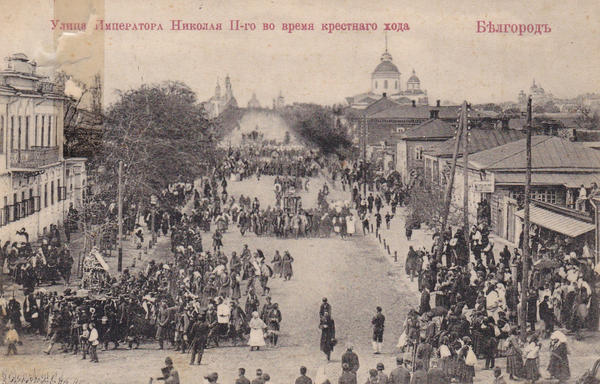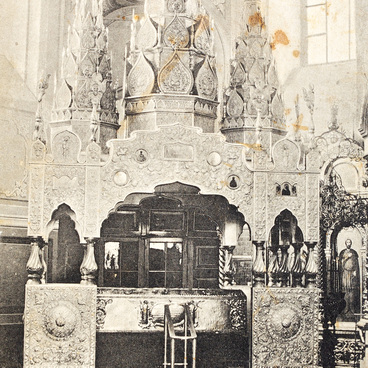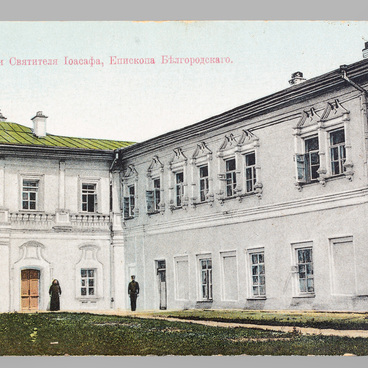For many years, people came to the Belgorod Holy Trinity Cathedral to venerate two main shrines: the holy relics of Bishop Joasaph and the miraculous image of Saint Nicholas the Wonderworker, known as the icon of Saint Nicholas Ratny.
Historical documents do not provide accurate information about the origin of this image, so researchers primarily rely on ancient legends. According to one of them, starting from the 16th century, the Tatars often besieged the outskirts of Belgorod and terrorized the monks of the Korenskaya Nikolayev hermitage and the inhabitants of the nearby village of Ustinka. During one of the raids, when the enemy detachment stopped at the local river Koren, the monks and Ustinka residents went to meet the enemies with a service of intercession, carrying the image of Saint Nicholas. This sight confused the Tatars, some of them fell into the water together with the horses, others fled.
The legend also describes the appearance of the icon in the source of Ustinka, which became a sign to arrange the hermitage there. Among the people, the image received the name of Nikolay Ratny and would protect Russian soldiers more than once.
Another version says that the icon got its name during the siege of Kazan by Ivan the Terrible, and after that, it was delivered to the Nikolayev monastery. The image remained there until 1765, when it was transferred to Belgorod and solemnly put in the Holy Trinity Cathedral.
Every year on May 5 — the day of the miraculous salvation from the Tatars — numerous pilgrims joined a procession with the icon of Saint Nicholas Ratny to the place of its miraculous glorification; the image stayed there until May 10, and after that, it was returned to the Belgorod monastery.
Starting at the Holy Trinity Cathedral, the procession passed Sobornaya and Emperor Nicholas II streets (now Svyato-Troitsky Boulevard and Grazhdansky Prospekt), reaching the station, turning right, crossing the railway tracks and going to the Peschansky Bridge. After crossing the bridge, the procession went along the Volchanskaya road to the very village of Ustinka.
The miraculous image was revered as an all-Russian treasure. Over the years, many Romanovs came to venerate it. In 1914, members of the imperial family visited this place for the last time.
In the early 1920s, shortly before the monastery was closed, the miraculous image mysteriously disappeared. It was retrieved in 1995. The icon was restored and put in a case in the Transfiguration Cathedral.
Historical documents do not provide accurate information about the origin of this image, so researchers primarily rely on ancient legends. According to one of them, starting from the 16th century, the Tatars often besieged the outskirts of Belgorod and terrorized the monks of the Korenskaya Nikolayev hermitage and the inhabitants of the nearby village of Ustinka. During one of the raids, when the enemy detachment stopped at the local river Koren, the monks and Ustinka residents went to meet the enemies with a service of intercession, carrying the image of Saint Nicholas. This sight confused the Tatars, some of them fell into the water together with the horses, others fled.
The legend also describes the appearance of the icon in the source of Ustinka, which became a sign to arrange the hermitage there. Among the people, the image received the name of Nikolay Ratny and would protect Russian soldiers more than once.
Another version says that the icon got its name during the siege of Kazan by Ivan the Terrible, and after that, it was delivered to the Nikolayev monastery. The image remained there until 1765, when it was transferred to Belgorod and solemnly put in the Holy Trinity Cathedral.
Every year on May 5 — the day of the miraculous salvation from the Tatars — numerous pilgrims joined a procession with the icon of Saint Nicholas Ratny to the place of its miraculous glorification; the image stayed there until May 10, and after that, it was returned to the Belgorod monastery.
Starting at the Holy Trinity Cathedral, the procession passed Sobornaya and Emperor Nicholas II streets (now Svyato-Troitsky Boulevard and Grazhdansky Prospekt), reaching the station, turning right, crossing the railway tracks and going to the Peschansky Bridge. After crossing the bridge, the procession went along the Volchanskaya road to the very village of Ustinka.
The miraculous image was revered as an all-Russian treasure. Over the years, many Romanovs came to venerate it. In 1914, members of the imperial family visited this place for the last time.
In the early 1920s, shortly before the monastery was closed, the miraculous image mysteriously disappeared. It was retrieved in 1995. The icon was restored and put in a case in the Transfiguration Cathedral.



